SITA + Thales—On Demand, In-Flight Entertainment
Thales and SITA have reported on the success of pairing Thales’ GateSync™ with SITA’s e-Aircraft Services to enable in-flight entertainment on demand to passengers’ smartphones, tablets and other devices.

Currently on trial with LAN Airlines, at Santiago Airport, it provides passengers with on-demand rich content straight to their own devices. This includes music, movies, news, TV series, PC games, interactive shopping, destination and flight information, all streamed within the cabin.
SITA provides connectivity for aircraft on the ground via Wi-Max, Wi-Fi, or cellular service and, through its subsidiary OnAir, in-flight connectivity through satellite-based broadband services. By using SITA’s network to deliver its in-flight entertainment (IFE), Thales avoids shipping hard drives and the need for manpower to upload content, while allowing frequent updates. SITA’s delivery of information is fast, secure and cost-effective, and it can handle other airline data, such as non-safety-critical operational aircraft communications, as well as the IFE content.
Stuart Dunleavy, Vice President of Media & Connectivity of Thales’s In Flight Entertainment Systems business, said, “The combination of Thales expertise in the development of in-flight entertainment and passenger connectivity solutions, with SITA’s recognized specialization in air transport communications and IT solutions is central to the success of this initiative. Each party is bringing its strengths to this project.”
Sebastien Fabre, Vice President, Integrated Networks, SITA, said, “SITA and Thales are unlocking the maximum benefits achievable from e-connected aircraft. This technology is not just for IFE, but can be for all data. In effect, we are making the aircraft an active node in the airline’s enterprise network, allowing data control by all stakeholders within the airline. Passengers get on-demand IFE, while time-sensitive data such as passenger manifests, daily news, meal inventories, surveys, crew logs and system performance data can also be securely transmitted to the airline’s operational systems.
“SITA is currently experiencing data volume growth on new generation aircraft (A380 and B787) approaching 100% compared to older generation aircraft. This demonstrates that the development of aircraft-centric IP service management is essential to meet the needs of airlines.”
This innovative trial from Thales and SITA rapidly accelerates the delivery of high speed Gatesync™ wireless ground connectivity for airlines, putting in place the building blocks for seamless e-enabled aircraft operations.
With the evolution of aeronautical wireless communications and mobile devices, and the growth of new generation aircraft, such as the Airbus A350 and Boeing 787, the Thales/SITA project demonstrates not only sophisticated on-demand IFE services for passengers, but new ways of operating aircraft.
Airlines can reduce costs and accelerate turnaround time because time-sensitive data can be transmitted wirelessly to, and from, an entire airline fleet.
This automates the labor-intensive and time-consuming processes of retrieving and loading large volumes of aircraft systems’ data.
The ground-based infrastructure, which SITA has installed and manages, uses SITA’s existing private backbone network for the secure deployment and management of data among airports, airlines and third parties to the e-enabled aircraft ecosystem around the world. It is fully integrated into SITA’s Command Centers, which provide round-the-clock monitoring and support services.
Onboard the aircraft, Thales provides GateSync components and integrates the system with onboard servers and avionics equipment.
* * * * * * * * *
Thomas Jefferson H.S., NASA + Orbital—A Spatial Excursion
A satellite developed and built by about 50 students from Thomas Jefferson High School for Science and Technology (Fairfax, Virginia) over the past eight years— the first ever built by high school students—is scheduled to be launched into orbit by NASA November 19, weather permitting.
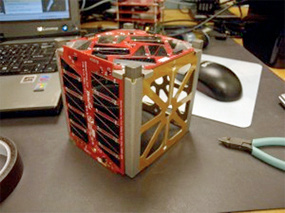
The satellite, known as TJ3Sat (pronounced TJ-cube-sat), is one of 20 satellites selected by NASA as part of its CubeSat Launch Initiative, which includes cube-shaped research satellites that weigh approximately three pounds, also known as nanosatellites.
TJ3Sat will serve primarily as an educational outreach tool and features a website that hosts live telemetry such as voltages, currents, temperatures, and other system status information available to the general public along with its history and other pertinent documents.
TJ3Sat will also include a voice synthesizer that can be used to take uploaded strings of text and convert them to voice.
TJ alumnus Jason Ethier proposed the project as a result of an internship he served with Orbital Sciences Corporation. Teacher Adam Kemp then developed a course in systems engineering that would focus on the design and construction of the first high school-built satellite.
A $30,000 donation from Orbital Sciences Corporation went toward the purchase of a cubesat kit, which formed the foundation of the satellite. Orbital has also provided the resources needed for the flight hardware, testing facilities for the finished spacecraft, and engineering mentorship by its employees.
Since 2006, teams of TJ students have been working on the design, construction, testing, and integration of TJ3Sat. Stensat LLC donated time, equipment, and expertise toward the development of the satellite.
Students used commercial off-the-shelf hardware for the structure of the satellite, radio, voice synthesizer, and a flight computer designed by Kemp.
The remainder of the hardware was developed as student senior research projects under the advisement of Kemp, Orbital engineers, and other industry volunteers.
The voice synthesizer can be used by students around the world who can send messages to celebrate holidays, cheer on their sports teams, and communicate with friends and family across the globe.
It is estimated that TJ3Sat will be in orbit for at least three months, depending on the deployment and acquisition of orbital parameters.
The team has developed enough hardware to construct three satellites, all currently stored at Orbital’s facility in the Dulles area. Plans are to move one of the test satellites, known as engineering units, back to the school for use in troubleshooting the satellite once it is in space. Scale models of TJ3Sat are on display at the school.
Satellite team members have documented all their work and will offer the designs of the original hardware and software they developed on the website so that future K-12 institutions can refer to the information as a resource as they develop their own hardware.
Thomas Jefferson High is a Fairfax County public school. (Article source:FairfaxNews.com)
* * * * * * * * *
Advantech Wireless—A Brazilian Bonus
Advantech Wireless Inc. has announced that it’s GaN based SapphireBlu™ Series of UltraLinear™ Ku-Band SSPA has received certification from the Brazilian National Telecommunication Agency (Anatel).
“This certification allows us to offer our customers in Brazil the most advanced and powerful solution in the market. More than 100 Klystrons and TWTs have been recently replaced by just 4 units of 3kW Ku-Band UltraLinear GaN SSPAs,” said Cristi Damian, VP Business Development at Advantech Wireless. “This disruptive technology allows remarkably high levels of performance and also impressive savings in CAPEX, OPEX, including energy cost”.
The New SapphireBlu Series of UltraLinear GaN based amplifiers from Advantech Wireless can cover multiple transponders, full DVB-S2 enabled and can save 8 to 15dB power compared to indoor Klystrons or linearized TWTs.
This new architecture is designed for Multi Carrier operations, with power expandable to 3kW by phase combining and redundant ready and is ideal for DTH Broadcasting, High Data Rate Telecom Services and Deep Space Communication.
Backed by more than 25 years of outdoor SSPA design and manufacturing experience combined with the traditional Advantech Wireless features, this is the only worldwide solution capable of offering the highest efficiency in use of satellite bandwidth and power.
* * * * * * * * *
NewSat Limited—Teleport Engrandizement
NewSat Limited has revealed that the City of Salisbury Council granted Development Plan consent for the expansion of NewSat’s Adelaide teleport facility in Mawson Lakes, South Australia.
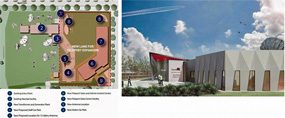
The planned facility expansion highlights the growth of business in SA and more specifically, the City of Salisbury. A larger teleport facility will advance global innovation, assist technology development and increase high tech job availability.
This consent acknowledges NewSat’s success to date and the opportunities that NewSat’s Jabiru-1 satellite and the teleport infrastructure investment in South Australia will create for local industry.
The teleport expansion is integral to the growth of NewSat and its plans to launch a fleet of satellites. Jabiru-1, Australia’s first commercial Ka-band satellite, is expected to generate in excess US$3 billion of revenue over 15 years.
The City of Salisbury’s economic and development team, operating from the Polaris Centre in Technology Park, have worked closely with the company to support the application process.
In commenting on the Development Plan consent, Gillian Aldridge, City of Salisbury Mayor said, “NewSat’s development application highlights how Salisbury is well placed to provide economic growth and support to industries and businesses, our staff have worked closely with NewSat to provide the company with significant insight and support and we are delighted that they have chosen to expand their operations in Mawson Lakes. This facility expansion is a great example of local business growth and will provide the community with high-tech innovative jobs into the future.”
Adrian Ballintine, NewSat Founder and CEO, said, “We are delighted that the City of Salisbury granted Development Plan consent for the Adelaide teleport facility expansion, confirming NewSat’s planned infrastructure investment in South Australia and development of our teleport facility here in Mawson Lakes.”
* * * * * * * * *
XipLink +Hughes—Ensuring Mexican Schools Are Connected
Xiplink has assisted with the successful integration and deployment of several XipLink Hub Optimization (XHO) appliances with a Hughes Network Systems HN VSAT satellite platform to support the Internet connectivity needs of a nationwide public school system in Mexico.
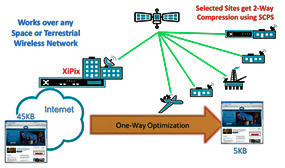
XipLink XHO illustration.
“We performed a rigorous analysis of the XipLink solution,” said David Jupin, vice president, International Division at Hughes. “The Hughes team had performance concerns surrounding the number of Internet session counts that are generated by the large number of schools on the network, but the XipLink XHO platform exceeded our expectations.”
The X ipLink appliance (XA) family of wireless link optimizers, scale from low-cost devices operating at 2Mbps to high-performance, multi-core platforms operating at 155Mbps and supporting more than 30,000 simultaneous TCP connections.
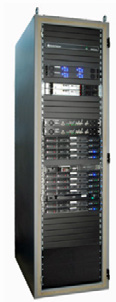
Photo of the Hughes HN System.
The appliances serve as the vehicles that deliver optimization features such as stream-based compression, byte caching, lossy and lossless compression capabilities, link bonding/balancing, and advanced cellular compression capabilities.
Bruce Bednarski , senior vice president of Business Development at XipLink,said, “ The XHO solution was specifically designed for large service networks with cons iderable Internet traffic. The system complements the Hughes TurboPage™ feature , dramatically reducing bandwidth requirements while simultaneously improving the end user browsing experience. Demonstrable efficiency and a lower overall operating cost struct ure is a requirement in winning and delivering sizeable public networks.”
XipLink’s flexible architecture allows the solution to scale-up with the demands of the network, protecting the customer’s initial investment in two ways. First,the XHO allows for infinite expansion via WCCP protocols and other integrated load balancing solutions, while simultaneously delivering critical fault tolerance.
Also, XipLink two-way optimizer appliances can be provisioned at the larger and more demanding remote locations to further optimize and reduce traffic generated at these sites and across the network.
* * * * * * * * *
The SIRIUS Chair Is Launched
Last month, Marc Pircher, head of Toulouse Space Center (CNES), Eric de Saintignon, and Jean-Pierre Vialaneix, respectively, director of Astrium in Toulouse and director of Thales Alenia Space in Toulouse, formalized their commitment concerning the creation of the Sirius Chair, alongside Bruno Sire, chairman of the Toulouse 1 Capitole University and Jacques Igalens, director of Toulouse Business School.
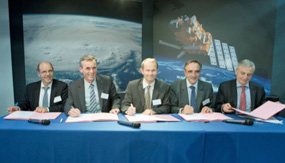
From left to right: Marc Pircher - Head of Toulouse Space Center – CNES, Eric de Saintignon - Director of Astrium in Toulouse, Didier Le Boulc'h — Director of R&D and Product Strategy—Thales Alenia Space France, Bruno Sire—President of Toulouse 1 Capitole University, Jacques Igalens—
The Sirius Chair was born in a place that is symbolic on two counts: The Cité de l’Espace, an emblem of Toulouse as the European capital for aerospace, and the Midi-Pyrénées region, which is the first aerospace cluster in Europe and a world leader in Earth observation, operational oceanography, location and navigation.
The three partners associated with the creation of the Sirius Chair, Astrium, CNES, and Thales Alenia Space, have actively participated in the creation of a unique research space.
Their common interest for the creation of a chair dedicated to the legal and managerial challenges of aerospace activities is an echo of the leading role played by these major industrial actors on a European scale.
The Sirius Chair will also strengthen the expertise of Aerospace Valley, a Toulouse-based business cluster of international caliber which leverages a dense network of 150 SMEs, engineering schools, universities, and research laboratories.
Eric of Saintignon, director of Astrium in Toulouse, underscores the benefits of having an international research group pertaining to the legal and economic issues of space activities:
“How will the legal framework evolve for companies of the space sector on a worldwide scale? Why is innovation managed differently in the space sector than in other industrial sectors? It is on this type of issues that the best experts, lawyers and economists, gathered within the SIRIUS Chair, will be working. Astrium wanted to be a part of this, because our position as number two worldwide, and especially as the only company in the world to be present in all space activities, led us to face very different issues in a sector that is perpetually evolving.”
Marc Pircher, Head of Toulouse Space Center, agrees with this idea... “We are always on the lookout for new applications, which often raise important questions. The example of observation and location satellites is enlightening: what indeed is our legal responsibility in case of poor integrity of space-based signals or data, or in terms of privacy? What are the legal issues with regards to insurances, individual freedom and image rights? This example is a good illustration of the issues which can come across our research and development.”
“The creation of the SIRIUS chair is an excellent initiative which confirms that Space is a sector with a strong potential that has only been very partially tapped until now,” Jean-Pierre Vialaneix, director of Thales Alenia Space in Toulouse explains.
“The topics that will be addressed in depth by top-ranking researchers and Ph.D. students will make it possible to compare expectations and constraints from institutions, territorial authorities, citizens and businesses to unearth new political, financial, legal or industrial models paving the way for future developments which will generate employment and economic benefits for France”.
Under the scientific leadership of Professor Lucien Rapp, research teams from UT1 Capitole and TBS will initiate studies on behalf of businesses belonging to the French aerospace industry.
They will contribute to their broadcasting through the organization of specialized and dedicated symposiums, seminars and workshops.
“This is why the Sirius Chair is an ambitious project, and a very symbolic one with regards to the partnerships implemented and the services provided, Lucien Rapp, professor at UT1 Capitole, scientific director for the Chair, and one of the best international legal experts in aerospace and telecommunications, said.
Denis Lacoste, scientific co-director of the Sirius Chair, indicated for his part that his research themes, “unexplored to date, will have a very strong added value from an industrial standpoint”, and will benefit from the “proximity between research teams and the industrial and institutional environments linked to the aerospace industry.”
The two scientific co-directors have both pointed out the significance of aerospace in Europe: “The Treaty of Lisbon has given Space a truly strategic dimension. This momentum continues today within the framework of the Horizon 2020 program, which has replaced the 7th European Research Framework Program, making aerospace one of the 6 priority industrial sectors to support.”
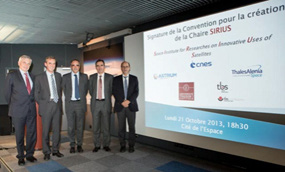
From left to right: Jacques Igalens—Director of Toulouse Business School, Eric de Saintignon—Director of Astrium in Toulouse, Bruno Sire—President of Toulouse 1 Capitole University, Jean-Pierre Vialaneix, Director of Thales Alenia Space in Toulouse, March Pircher—Head of Toulouse Space Center—CNES.
A European priority will echo favorably within the Sirius Chair, as evidenced by the ambitious research program announced by the partners. “We will strengthen our understanding of the legal and regulatory phenomena and mechanisms, as well as those pertaining to management or economy, which are directly linked to the specificities of the space sector. I am thinking in particular of market procedures, litigation, intellectual and industrial property, competition law applied to space activities, or even to personal data and privacy protection,” Jacques Igalens, Director of TBS, specifies. These themes will build on the strength of a wide network of qualified researchers, in France and abroad.
The Sirius Chair is based upon a skills network composed of doctoral students, post-doctoral students and experts, hailing from various geographic backgrounds.
The Sirius Chair will place this skills network at the service of the European space industry. Astrium, CNES, and Thales Alenia Space will be involved with the organization of international symposia and specialized seminars in Toulouse, on topical subjects relating to the whole space industry.
A chair makes it possible to finance research activities (supervision of Ph.D.s, studies, symposia) over time through the support of private or public actors. Created for a first period of five years, the Sirius Chair is financed by CNES, Astrium and Thales Alenia Space through the Toulouse Business School Foundation.
* * * * * * * * *
Spacecom—East African Entry
Spacecom, the operator of the AMOS satellite fleet, has announced that its AMOS-5 at 17 degrees East has won another broadcast deal in East Africa.
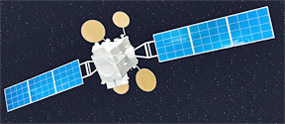
Artistic rendition of the AMOS-5 satellite.
Under the new $3.6 million contract, Spacecom will provide analog to digital migration broadcast services to an East African Digital Terrestrial Transmission (DTT) and Direct To Home (DTH) operator.
he operator’s DTT distribution and DTH signal to the region, composed of dozens of channels that are focused on local and international content including news, sports, entertainment and family programming, will be transmitted on AMOS-5’s Ku-band (Ku-3).
Earlier this month, Spacecom announced it had won an East African digital migration broadcast project worth $5.9 million.
AMOS-5 was designed and built specifically for the African market with a pan-African C-band beam and three Ku-bands that cover the continent and provide connectivity to Europe and the Middle East.
The satellite’s position at 17 degrees East enables its signal to reach every region in Sub-Saharan Africa.
* * * * * * * * *
iDirect + SkyVision—Ghana Academy Receives Benefits
VT iDirect, Inc. (iDirect), a company of VT Systems, Inc. (VT Systems), has announced that SkyVision, a global IP telecommunications service provider to emerging markets, has donated an iDirect-powered satellite network for the Crossover International Academy, a K-8 school located in the village of Tongor-Attokrokpo, Ghana.
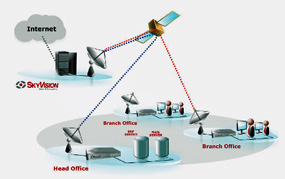
The network was implemented as part of a joint effort between iDirect and SkyVision to help the academy improve its educational offering by providing underprivileged students with online educational resources.
SkyVision’s SkyDirect VSAT service, based on the iDirect platform, was chosen to provide the service due to its proven reliable connectivity.
The VSAT service enhances the way students learn and their overall education experience with Internet-based tools such as streaming video, social media, email and educational programs. For example, students can enhance reading levels by using uploaded video tutorials and online programs, such as PRO reading technology and Total Reader™.
Crossover is also leveraging the service to connect with Pegasus, its sister school in the US.
The two schools can now communicate with one another via email, implement student debates over Skype and FaceTime, prepare weekly assignments and lesson plans, create online courses for the school’s staff, and organize online fundraising activities.




